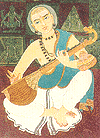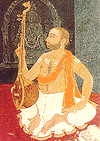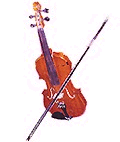


The trinity of Carnatic Classical music
- Muthuswamy Deekshitar
- Thyagaraja Swamikal
- Shyama Sasthrikal
Music of India
The music of India is perhaps one of the oldest in the world. It is also a major system of music that is essentially melodic; and what is of great significance and interest is that it has retained this character to this day. This is in contrast to European culture, for example, where the early melodic has changed into the current harmonic music. The social pattern of India today is the result of many ancient ones and the way of life on this land has been woven of fibres of different hues and textures. It is supposed that the Negrito races, the remnants of which are still with us were the most ancient in India. The Dravidians, Mongoloids and Aryans were later cultural incursions. And the music of India today shows this cultural admixture. The tribal people in various parts of the country - the Pulayans, the Oraons, the Santals, the Savaras, the Chenchus, the Bhils and others - more or less isolated in pockets - have their own characteristic music and dance. This tribal music contributed a lot to the general mould of our music. The present day Indian music have two major systems - Northern Classical music (known as Hindustani Classical music) and the Southern Classical music (known as Karnatak Classical music). In general they have the same basis, being melodic and governed by rules of raga and tala structure. The Karnataka system is the art form of southern India (Kerala, Tamilnadu, Andhra and Karnataka). The rest of India follows the Hindustani system.Raaga and Tala
 In essence, a raga is a melodic scheme governed by certain traditional rules, but providing a great freedom for improvisation. These rules define and determine the notes Carnatic music styleof a scale that should be used, their order, prominent and necessary melodic idioms which give a particular 'Colour' to the scheme. Based on these more or less strict limitations, the musician is free to create and herein lies his genius. The raga has, of course, to be pleasing : "A raga is called by the learned that kind of sound composition which is adorned with musical notes in some peculiarly stationary, or ascending, or descending, or moving values, which have the effect of colouring the hearts of men". The tala is a rhythmic arrangement of beats in a cyclic manner. Each cycle is complete in itself and it is repetitive. The cycle is divided into sections which may or may not be equal. It is formed by the addition of time units in a defined manner. But what is of real significance is the closed or cyclic arrangement. This is the essential difference between tala and rhythm. A degree of difference exists in the approach to raga formation in the Hindustani and Karnatak systems. And it would be worth discussing. It is commonly found that Hindustani raga-s have more than seven notes; not only so - two semitones are often juxtaposed.
North Indian music has also two interesting psychological attributes of raga. One is the 'time' theory and the other is the 'dhyanamoorthi'. A Hindustani raga has also usually associated with it the time of the day. Every raga has been ascribed a watch of the day and no musician will sing or play it out of this temporal context. There are certain traditional empirical rules of the thumb, to determine the diurnal relations. It is usual here to attribute a particular season and time to raga-s; but seasonal connections are not so specific. Some of the more important examples are the raga-s Vasant and Malhar. The first is of the spring and the second is of the rains. There is a story of Tansen and how his life saved by Malhar. In Karanataka system raga-s like Boopalam, Mayamalava gaula are preferably rendered in the morning, there is nothing to prevent their being sung at other times of the day. Perhaps, the time restriction is stricter in one or two cases like Boopalam. For a south Indian musician has a wide choice of raga-s for a concert. For a north Indian musician the choice become restricted. Urbanization has cut both the artiste and the audience of these two music systems off from direct contact with nature.
In essence, a raga is a melodic scheme governed by certain traditional rules, but providing a great freedom for improvisation. These rules define and determine the notes Carnatic music styleof a scale that should be used, their order, prominent and necessary melodic idioms which give a particular 'Colour' to the scheme. Based on these more or less strict limitations, the musician is free to create and herein lies his genius. The raga has, of course, to be pleasing : "A raga is called by the learned that kind of sound composition which is adorned with musical notes in some peculiarly stationary, or ascending, or descending, or moving values, which have the effect of colouring the hearts of men". The tala is a rhythmic arrangement of beats in a cyclic manner. Each cycle is complete in itself and it is repetitive. The cycle is divided into sections which may or may not be equal. It is formed by the addition of time units in a defined manner. But what is of real significance is the closed or cyclic arrangement. This is the essential difference between tala and rhythm. A degree of difference exists in the approach to raga formation in the Hindustani and Karnatak systems. And it would be worth discussing. It is commonly found that Hindustani raga-s have more than seven notes; not only so - two semitones are often juxtaposed.
North Indian music has also two interesting psychological attributes of raga. One is the 'time' theory and the other is the 'dhyanamoorthi'. A Hindustani raga has also usually associated with it the time of the day. Every raga has been ascribed a watch of the day and no musician will sing or play it out of this temporal context. There are certain traditional empirical rules of the thumb, to determine the diurnal relations. It is usual here to attribute a particular season and time to raga-s; but seasonal connections are not so specific. Some of the more important examples are the raga-s Vasant and Malhar. The first is of the spring and the second is of the rains. There is a story of Tansen and how his life saved by Malhar. In Karanataka system raga-s like Boopalam, Mayamalava gaula are preferably rendered in the morning, there is nothing to prevent their being sung at other times of the day. Perhaps, the time restriction is stricter in one or two cases like Boopalam. For a south Indian musician has a wide choice of raga-s for a concert. For a north Indian musician the choice become restricted. Urbanization has cut both the artiste and the audience of these two music systems off from direct contact with nature.